
Dante’s Inferno (1967)—which carries the subtitle “The Private Life of Dante Gabriel Rossetti, Poet and Painter”—is Ken Russell’s most ambitious TV film, and one of the most important of all his works in ways that may not be readily apparent. While it is not related to Dante’s epic poem, the title is well chosen, since the film—detailing the life of Dante Gabriel Rossetti (Oliver Reed in his second Russell film) and the Pre-Raphaelite Brotherhood—can be taken as a journey through Rossetti’s personal hell, though it is a hell largely of his own making. Russell offers a sharp, incisive and highly critical—though amused and amusingly fond and finally sadly sympathetic—portrait of its subject and the PRB. It’s also one that was—and remains—very in keeping with the mood of the young at the time it was made. (Once again, Russell presents a bridge between generations.) By contrast Always on Sunday (1965) is a relatively simple, completely uncritical look at the life and strange career of French painter Henri Rousseau (played by British “primitive” artist James Lloyd, on whom Russell had made a documentary a couple of years earlier). The only thing critical in this warm, loving little film on the naive (both in artistic style and in life) painter lies in its attack on the hidebound critics and tastemakers of the day, who laughed at, denigrated, and dismissed Rousseau’s work during his lifetime.
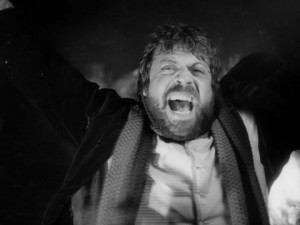
Dante’s Inferno starts not with one, but two “grabber” scenes back to back. The first is the macabre and mysterious image of a coffin being disinterred by torchlight, the lid pried open revealing the decomposing body therein, and finally a rotting book being retrieved. This will come to have great significance and the business (though not the shot itself) of removing the book from the coffin will be repeated several times in the course of the film. This is immediately followed by an event from years earlier with Dante Garbiel Rossetti literally bursting into the film by leaping over a bonfire in an expression of exuberance and life. It’s a more than apt introduction to the character.
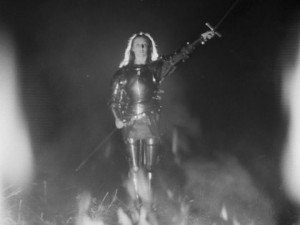
We’re in a scene frenzied destruction with a group of men burning paintings. The narration informs us, “Arson, raping, riot, civil insurrection is terrifying Europe. The date is 1848. In England rebels conspire to overthrow the Royal Academy of Art. The rebels are students and idealists. They are against industry, state religion, and official art. They would replace these with notions of honor, truth, and beauty—quite unsuited to our times.” This is by way of introducing us to the idea—and lofty, if constantly compromised, goals—of the Pre-Raphaelite Brotherhood, of which Rossetti was a founder. They had notions of the rejection of academic art in favor of different sort of art that was more detailed, richer in color, and which conveyed ideas—grounded to some extent in a fascination with medieval times, which they felt were more pure than modern times.
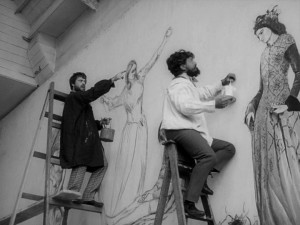
It is surely no accident that Russell turned to this subject in 1967 when a not dissimilar counterculture movement was in full sway—albeit on a grander scale than the PRB ever achieved. The comparisons, as I noted, are inevitable, and it is probably not coincidental that 1960s art world figures like Derek Boshier and Clive Goodwin were in the cast. Once again—as in Isadora (1966)—the behavior of the subjects, especially Rossetti, is easily equated with that of rock stars. And just as inevitable are the film’s depictions of the self-indulgences and frequent absurdities inherent in both ages. If Dante’s Inferno made its historical characters accessible to its modern counterparts—and I’d argue that it did—it also held up a mirror that didn’t necessarily show those counterparts an image that flattered them. On the other hand, neither does it condemn them or the Pre-Raphaelites. It merely looks at the gap between the ideals and the reality, between the men and their works.
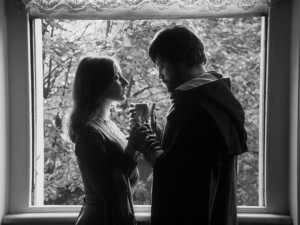
As the title indicates, the film is primarily about Rossetti—and largely about his relationship with (and ultimate marriage to) PRB muse Elizabeth “Lizzie” Siddal (Judith Parris in the first of her seven appearances for Russell), the model for Ophelia in John Everett Millais’ famous painting—as well as many of Rossetti’s paintings. (The Millais painting was recently seen in Lars von Trier’s recent Melancholia, where Kirsten Dunst recreated the pose as well.) The relationship is a difficult one. Not only is Lizzie—who works in a milliner’s shop—far from being Rossetti’s intellectual equal, but she’s too proper for his libidinous nature, and she’s sickly—a condition not helped by her being introduced to laudunum.
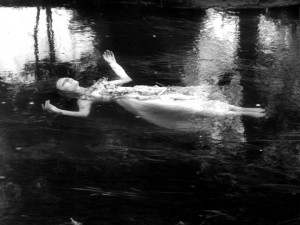
Rossetti tries to elevate Lizzie to his level, teaching her art—for which she actually has some aptitude, and which captures the attention of the influential art critic John Ruskin (Clive Godwin)—but it never really takes, and even after their marriage the relationship is strained. This is certainly not helped by Rossetti’s infiedlities (some of which date back to their pre-marital days). As the film progresses, Lizzie sinks lower in both health and spirit, until she OD’s on laudanum—her death depicted by Russell with her image as Ophelia floating away on the water. This act prompts Rossetti—in a fit of contrition—to bury his poems with her, despite his sister (Isabella Telezynska—under the name Iza Teller—in her fourth of seven Russell films) insisting that no good can come of this morbidly romantic gesture.
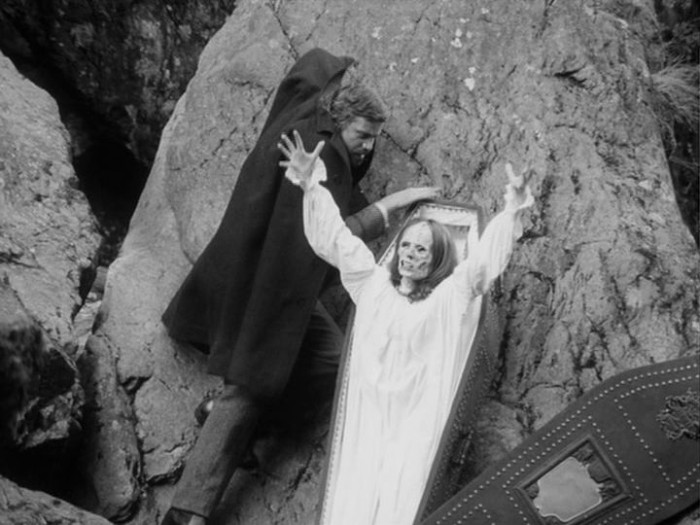
Indeed no good does come of it, since by now we realize the significance of the film’s first image. As the year’s pass, the increasingly dissolute Rossetti—already haunted by images of Lizzie—allows himself to be talked in to having her grave opened and the poems retrieved (after all, they have monetary value). This action, of course, only drives Rossetti further into his haunted state—something that sets the stage for Rossetti’s own (botched) suicide bid and the film’s most terrifyingly nightmarish fantasy.
Russell’s complete mastery of his medium has never been more evident than in the final scenes of Dante’s Inferno where Rossetti wanders through the wreckage of his life. These last scenes are among the most accomplished in his filmography. He takes Rossetti through a breathtaking “freak-out”—set to Gustav Holst’s “Saturn, the Bringer of Old Age”—where the artist tries to drive out images that haunt him, culminating in the one he cannot shake: Lizzie as she appeared to him in idealized medieval form through the flames at the beginning of the film. This seamlessly segues into an imaginary conversation between him and (presumably) Lizzie, set to Holst’s “Neptune, the Mystic,” and using the words of Rossetti’s poem “Alas, So Long!”—
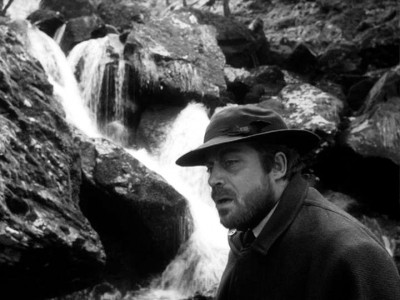
Ah! dear one, we were young so long,
It seemed that youth would never go,
For skies and trees were ever in song
And water in singing flow
In the days we never again shall know.
Alas, so long!
Ah! then was it all Spring weather?
Nay, but we were young and together.
Ah! dear one, I’ve been old so long,
It seems that age is loth to part,
Though days and years have never a song,
And oh! have they still the art
That warmed the pulses of heart to heart?
Alas, so long!
The film, however, concludes on the sad reality of Rossetti’s lot in life with his faithful mistress from his pre-marital days, Fanny Cornforth (played by Benny Hill alumnus Pat Ashton for maximum good-natured vulgarity), climbing up the mountain after him—not to comfort him, but to upbraid him for making off with the gin bottle. After which, all that’s left is for the shell of Rossetti to wander down the hillside into the mist—and the ironic ending music of “I Want to Be Happy” playing on the calliope that has offered similar content throughout the film. (Interestingly, this song would become the theme—along with other songs from the 1925 stage show No, No, Nanette—in his 2000 short film Lion’s Mouth, a kind of calling card “to remind people I’m still alive”—and one that will almost never be seen owing to the song rights.)
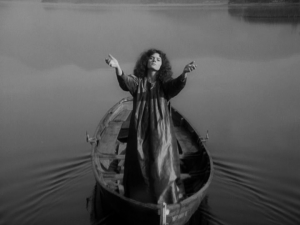
Dante’s Inferno is in many ways as good and assured as anything Russell ever made. What is most amazing about the film and its eerie beauty is the way he managed to capture the look of the Pre-Raphaelite paintings within the limitations of the black and white cinematography. He would capture some of the same look in his other film about poets, the criminally underseen two part TV film, Clouds of Glory (1978). He even repeated some of the imagery, but in color this time. Then again—and I think this needs to be understood—the Pre-Raphaelites informed a good deal of the look to many of his films. So, if you think this film paints a condemning portrait of Rossetti and PRB, you might want to consider that it’s actually a portrait made by a man who loved these artists and their work, but made by a man who wasn’t blind to their failings.
The film’s place in Ken Russell’s filmography is especially important in that this is the movie that introduced him to the Lake District. Russell always said that he’d read about Rossetti and Fanny having a fight with gin bottles up there, so he decided to go take a look for himself. It changed his life. Not only did he ultimately buy a home there—Coombe Cottage in Borrowdale—where he lived until his second marriage fell apart in 1990, but it enlarged on his already somewhat pantheistic nature. It also became his favorite and most famous location.
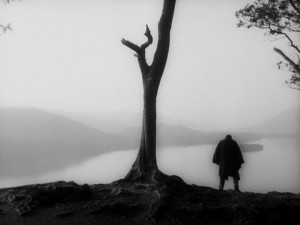
Starting with this film, he used it in Dance of the Seven Veils (1970), The Devils (1971), Mahler (1974), Tommy (1975), Clouds of Glory, The Rainbow (1989), and his autobiographical A British Picture (1989). In fact, he made a TV film called Song of the Lakes some time in the 1980s. Somehow this film has slipped through the cracks and isn’t included in most filmographies, though a clip from it appears in Ken Russell’s ABC of British Music (1986). The Lake District became to Russell what Monument Valley was to John Ford. Russell always tended to downplay his “ownership” of the location, saying that it was impossible to point your camera anywhere in the Lake District and not come up with a great shot. If that’s so, why is it only in Russell’s films that it truly stands out?
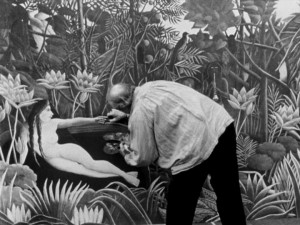
The much simpler Always on Sunday is, in many ways, a lesser work. Running only 45 minutes, it’s a more or less straightforward look—well, as straightforward as a Ken Russell film can be—at the life and paintings of Henri Rousseau, who retired from his position as a customs inspector to paint full-time, rather than just on Sundays. There’s actually a great deal to be said for this sweetly quirky little film. It’s actually something of an advance in what he could “get away with” at the BBC. While it relies heavily on a narration (delivered by Oliver Reed), Russell here uses dialogue having to resort to the subterfuge of creating a film within a film as he did in The Debussy Film made earlier that year.
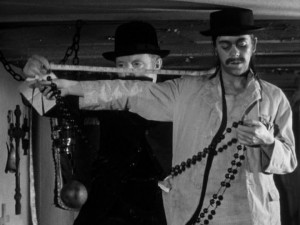
More surprising is what he was allowed to do in terms of casting. Since Rousseau was a simple man and a wholly self-taught one with a working class background, Russell conveyed this by having James Lloyd deliver his dialogue in a working class English accent. (Perhaps the BBC was reassured that no one would think this really was the French painter, since this was such a worry of their concerning dramatic recreations.) Then again, Russell opted to cast a woman, Annette Robertson (who had been in The Debussy Film), in drag as the diminutive writer (and eccentric) Alfred Jarry, who was one of Rousseau’s earliest champions and who detested the reigning bourgeois tastemakers of the day. (There’s a lot more to the story of this casting that I’m not going to get into here.)
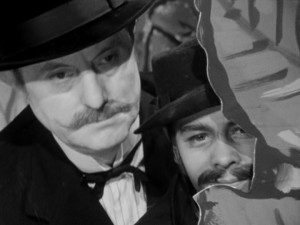
Most of the humor in Always on Sunday is gentle in nature—as befits its hero, who blissfully goes through life neither understanding, nor even completely realizing, the neglect, ridicule and contempt that tended to greet him and his paintings. (A good companion piece to this would be Russell’s 1990 TV film The Strange Affliction of Anton Bruckner, dealing with another irredeemably naive innocent.) There is an exception, however, in the staging of Jarry’s play Ubu Roi (King Ubu)—a deliberately provocative attack on the bourgeois that prompted a riot and got it banned when it was premiered in 1896. The film presents Ubu as both the character in the play and as the personification of the worst of Rousseau’s middle class detractors (both played by Bryan Pringle in the third of his four Russell appearances). It then proceeds to give us part of the play with its wholesale use of the word “shittr” and the riot that ensues (with the audience literally turning into “bourgeois pigs”).
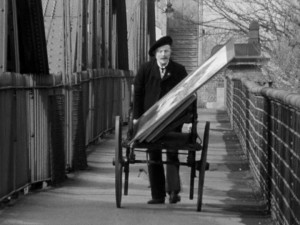
The play, however much a disaster, cements—for a time—a strange friendship between Rousseau and Jarry. If Rousseau even comprehends how strange and self-destructive Jarry is, he shows no sign of it, seemingly just content in the companionship. Actually, that describes Rousseau’s relationship with just about everyone, since he’s shown as completely without guile and resentment. If his friends make fun of him or make him the butt of their jokes (and nearly everyone from Appolinaire to Picasso does, even when they recognize the genius of his work), he’s completely oblivious to it.
The film’s biggest drawback—even though it does as well as it can by them—lies in the fact that Rousseau’s paintings don’t entirely come across in black and white. This is one of the BBC films where one really cries out for the missing element of color. Still, it captures a good bit of the feel of them. And it remains one of Russell’s most loving works—but with a slight sting in its tail when Reed’s final comment (over the image of Rousseau carting one of his canvases on a wheelbarrow) that one of Rousseau’s painting is now (1965) valued at a million dollars.



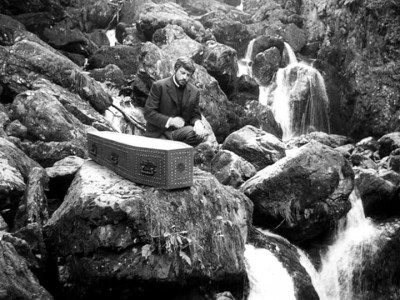
Before you comment
The comments section is here to provide a platform for civil dialogue on the issues we face together as a local community. Xpress is committed to offering this platform for all voices, but when the tone of the discussion gets nasty or strays off topic, we believe many people choose not to participate. Xpress editors are determined to moderate comments to ensure a constructive interchange is maintained. All comments judged not to be in keeping with the spirit of civil discourse will be removed and repeat violators will be banned. See here for our terms of service. Thank you for being part of this effort to promote respectful discussion.